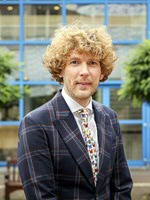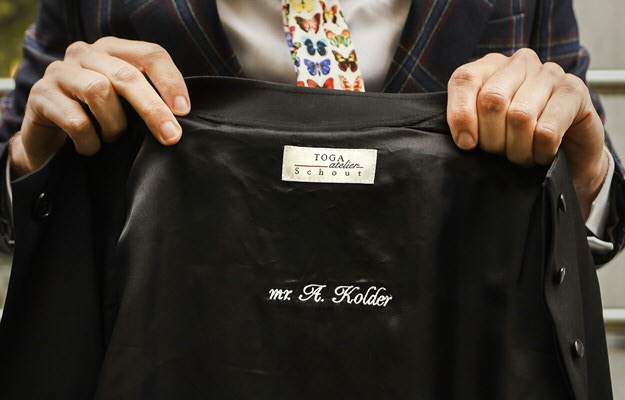Advocaat én hoogleraar personenschade? Arvin Kolder doet het, en dit geeft hem veel voldoening

Als advocaat staat Arvin Kolder cliënten bij in de rechtszaal in zaken over personenschade. Eens per week ruilt hij zijn advocatentoga echter voor die van hoogleraar, om als bijzonder hoogleraar Personenschade met rechtenstudenten van de RUG de boeken in te duiken. Zelf houdt Kolder van zijn dubbelrol: ‘Ik zie mezelf dit nog jaren zo doen.’ Hoe is het om die rol te vervullen? En hoe kan zijn wetenschappelijke onderzoek in de praktijk helpen?
Tekst: Thomas Vos, afd. Communicatie RUG / Foto’s: Henk Veenstra
Strak in een blauw maatpak en met een flinke bos krullen banjert Arvin Kolder door het kantoor van Kolder Vorsselman Advocaten in Groningen-Zuid. Het pand valt nauwelijks op aan de buitenkant, maar het advocatenkantoor op de eerste verdieping is modern en oogt industrieel. Er hangt een grote foto van een fabriekshal. Kolder: ‘Het kan zijn dat iemand zo nog even wat komt opmeten. We zijn bezig met de oprichting van een opleidingsinstelling naast ons advocatenwerk, waarmee we cursussen voor advocaten en andere letselschadeprofessionals gaan geven. Ook voor studenten bieden we gratis cursussen aan, zodat ze kennis kunnen maken met het vak.’
Enige in Nederland
Aan ambitie geen gebrek bij Kolder. Bij zijn aanstelling als bijzonder hoogleraar in januari 2020 was hij de eerste hoogleraar personenschade (letsel- of overlijdensschade door toedoen van een ander) in Nederland. Nog steeds is hij de enige. De RUG stelde de leerstoel in op initiatief van de Vereniging van Letselschade Advocaten (LSA), die hiermee wil bijdragen aan een verbetering van de afhandeling van personenschade. Kolder bleek de meeste geschikte kandidaat.

Voetballer
De weg naar het hoogleraarschap en de advocatuur lag voor Kolder niet meteen voor de hand. In zijn jongere jaren was Kolder een veelbelovende voetballer, net als zijn broer Marnix, die later prof werd: ‘Beiden studeerden en voetbalden we, elke dag weer. Op den duur moet je een keuze maken. We speelden wel eens uit tegen Sparta, waarna we diep in de nacht uit Rotterdam terugkwamen en ik ‘s ochtends alweer in de collegebanken moest zitten. Dat was niet meer te doen op een gegeven moment.’ Kolder koos voor zijn studie rechten: ‘Daar haalde ik de meeste voldoening uit. En als ik kijk waar ik nu sta, ben ik blij dat ik die keuze heb gemaakt.’ In drie jaar en tien maanden tijd haalde Kolder niet alleen zijn bachelor, maar ook cum laude een master Nederlands Recht. Kolder: ‘De studie heb ik er naast het voetballen in feite doorheen gejaagd. Ik heb ook nooit op kamers gewoond. Heel saai eigenlijk.’ Hij liep als student stage bij Yspeert Advocaten en Houthoff in Amsterdam en ontdekte al gauw dat hij advocaat wilde worden.
Struikelen over stoeptegels
Personenschade vond hij toen al buitengewoon interessant. Tijdens zijn studie volgde hij er in de master een keuzevak over, dat hij nu zelf coördineert, maar toen gegeven werd door (nu honorair hoogleraar) Fokko Oldenhuis: ‘Zijn colleges grepen me. Letselschade gaat echt over mensen en alledaagse gebeurtenissen. Struikelen over een stoeptegel, aangereden worden op een zebrapad… de gevolgen daarvan kunnen heel ingrijpend zijn. Je toekomst kan er volledig door veranderen. Dan is het mooi als je toch iets voor die mensen kan betekenen.’
Promoveren
Hij schreef zijn scriptie over werkgeversaansprakelijkheid. Dit wakkerde nóg iets aan: ‘Ik vond onderzoek doen ook heel boeiend.’ Kolder besloot zowel advocaat als promovendus te worden. Bij een in personenschade gespecialiseerd advocatenkantoor in Emmen kreeg hij de ruimte en kon hij vier dagen als advocaat werken, zodat hij ook tijd had voor zijn promotieonderzoek, dat werd begeleid door Mark Wissink en Fokko Oldenhuis. Kolder: ‘Ze vonden het op het advocatenkantoor waardevol om ook iemand met een sterk academische blik rond te hebben lopen.’
Wisselwerking
Nu is Kolder vier dagen advocaat en één dag hoogleraar. Hij begeleidt scripties, geeft hoorcolleges, organiseert congressen en meer. Volgens Kolder biedt zijn dubbelrol voordelen: ‘Wereldschokkende veranderingen brengt het hoogleraarschap niet met zich mee. In mijn rol als advocaat noem ik mijn hoogleraarschap ook liever niet. Of de titel helpt om adviezen wat meer gezag te geven? Mensen kijken er misschien toch anders naar. Maar uiteindelijk gaat het gewoon om de inhoud.’ Bovendien helpt Kolders academische rol hem om afstand te nemen van de praktijk en met andere academici dieper op zaken in te gaan: ‘Dat geeft mij bagage voor mijn werk als advocaat.’ En zijn werk als advocaat heeft weer voordelen voor zijn werk als hoogleraar. Kolder: ‘Ik weet daardoor wat er in de praktijk speelt en waar bijvoorbeeld behoefte is aan meer onderzoek.’

Whiplash
Zo is hij in zijn onderzoek nu veel bezig met letsel door whiplash, een van de meest voorkomende vormen van personenschade. Dit letsel kan ontstaan door bijvoorbeeld een aanrijding van achteren in het verkeer. Letsel is medisch moeilijk aan te tonen, maar de klachten (o.a. hoofdpijn en concentratieproblemen) kunnen voor slachtoffers hevig en langdurig zijn. Kolder: ‘Mensen kunnen daardoor arbeidsongeschikt raken, zonder aantoonbaar letsel.’ Juridisch levert dat lastige situaties op; zijn de klachten wel aannemelijk? Komen ze wel door het ongeval? Kolder onderzoekt hoe juristen hier het beste mee om kunnen gaan. Hij ontwikkelde een stappenplan om whiplashzaken juridisch te kunnen beoordelen.
Rode draad als bewijs
Kolder: ‘Dat een arts niets kan vinden betekent niet automatisch dat er juridisch niks aan de hand is. Zolang het klachtenpatroon na een ongeval consistent is - je bent bijvoorbeeld bij allerlei artsen geweest met nekklachten - dan kun je er onder omstandigheden van uitgaan dat dit verhaal plausibel is. Die rode draad met klachten kan dan als bewijs worden aangevoerd.’ Ook over de eis dat deze klachten vervolgens nog aan het ongeval te relateren moeten zijn, publiceerde Kolder: ‘Je ziet dat daar wel wat mee wordt gedaan in de rechtspraak over whiplashzaken. Ik hoop daarmee te hebben geholpen bij het beter afhandelen van dat soort toch vaak lastige zaken.’
Gouden greep
Zoals hij er nu tegenaan kijkt, blijft hij tot aan zijn pensioen graag onderwijs geven, onderzoek doen én mensen bijstaan in de rechtszaal. Kolder: ‘De combinatie van wetenschap en praktijk is echt een gouden greep voor mij geweest. Beide vakgebieden versterken elkaar, en ik vind het allemaal ook ontzettend leuk. De komende jaren wil ik hier zeker mee doorgaan, zodat ik in die beide werelden mijn steentje hopelijk kan blijven bijdragen.’
Meer informatie
Meer nieuws
-
08 december 2025
Kleurrijke Kopstukken: Bert Röling
